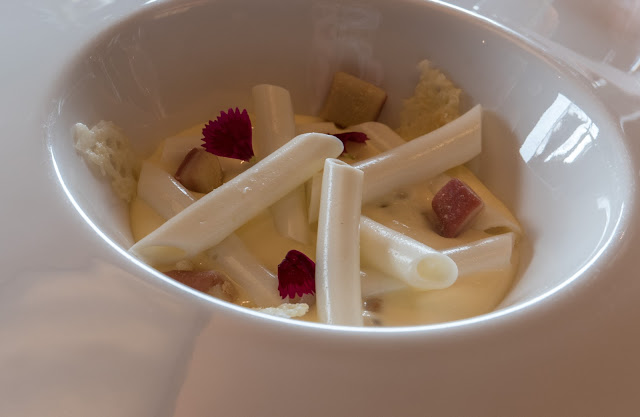 |
|
A tapestry
in the tasting room
|
In
1972 Alejandro Fernandez was at the forefront of one of the greatest wine
stories in the 20th century, the late renaissance of an old and noble wine
region leading to the international rebirth of Spanish wine, when he licensed a
bodega in Pesquera. This was well before
Ribera del Duero was a well-known region for quality wines, but vines in the
region date back to the eleventh century. A 16th-century lagar press
house served as grape receiving and processing through the 1982 harvest shared
by Alejandro’s father with other local producers. It has been carefully restored and visitors
are shown a video explaining how it worked.
But let's back up a bit to his early years in Ribera del Duero. Things were rather different in the 70s; beet
and cereal crops were far more profitable than wine. Alejandro Fernández
started to make a living selling and then later manufacturing beet
harvesters. His machine shop which ceased
business in 1985 still serves as the source for stainless tanks and countless
other items for vineyard and bodega. If
childhood shapes an individual’s future, Alejandro, following family tradition,
learned from his father to make wine using grapes from small vineyards. In his youth he nurtured a dream of one day
running a bodega. The goal has been
fully accomplished. Fernández and his
family own a small red wine empire that spreads across the Duero and
beyond. A current total of over 500
acres of mature vineyard is spread out over a variety of terroirs. Wines
produced by Alejandro Fernández are made exclusively from the difficult
Tempranillo of which he is considered a master. Since he made the first 1975
Tinto Pesquera, Alejandro Fernández has been listening to his heart. An unconventional winemaker who will turn 85
on August 11th, he has always been completely indifferent to fashion trends.
Alejandro just keeps on crafting the wines he likes to drink: powerful,
fruit-driven Tempranillo reds capable of ageing.
What lead
him to pioneer wine growing in Ribera’s plateau; how did he come to think of
it? “Anyone who has hiked to the area’s hills knows that a jacket is not needed
in the afternoon, but once you are back in the village the jacket becomes necessary.
At night, however, temperature is far lower in the plateau”, his description of
day/night temperature changes, a key element to achieve optimum ripeness in
Ribera del Duero wines. He is not a
traditionalist. Although grapes are
harvested by hand, all of his vines are trellised and include drip irrigation
systems. Alejandro is convinced that in
very hot years extra water must be supplied to plants “in order to avoid roots
sucking too much from grapes”. He is
convinced that the most crucial element in winemaking is the harvest. He may
pick earlier or later than others. “I don’t care about the calendar; neither
people nor grapes have calendars”.
Pesquera reds are notable for their pronounced varietal expression and
generous fruit-driven character. “I have never filtered neither used egg
whites,” says Alejandro. Alejandro doesn’t filter the wines because he thinks
they would lose flavor; not that he really knew that; he is just an intuitive
winemaker. Alejandro’s reds have
remained unchanged. They used to be the most powerful reds but as trends
evolved, they now feel more balanced.
They also used to be expensive but as prices haven’t climbed that much,
now they are even good value.
His
premium range includes Janus, which he launched in the 1980s (it has been made
in 1982, 1986, 1991, 1994, 1995 and 2003, according to the winery’s records)
and Millenium, which dates from the 1990s and has been made in 1996, 2002 and
2004. Some Pesquera Gran Reserva can also be included in this group. The main difference between Janus and
Millenium is that the former comes from the best Viña Alta plots while grapes
for the latter are sourced at El Llano de Santiago. Both are particularly large
vineyards located in the plateau roughly at 900 meters high.
Alejando’s
wife Esperanza has been instrumental in building the company. Their four
daughters, Lucía, Olga, Mari Cruz and Eva manage the business with Eva, who
trained as a winemaker, overseeing the winemaking.




















